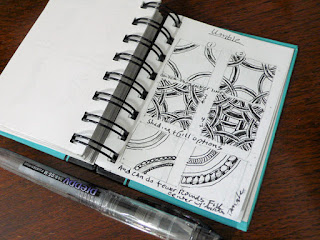 |
| What a motley crew...but it's MY motley crew! |
Belated wishes for a Happy Thanksgiving to my readers who celebrate that. Even though I wasn't entertaining guests or being one myself, I did pop a turkey breast in the oven and fix yams, mashed potatoes, gravy and cranberry sauce to enjoy while remembering my recent family gathering. I believe this is the only picture we got of all of us together, thanks to the quick thinking of a nephew and an accommodating waitress. We're a family of storytellers and the storytelling pretty much trumped thoughts of picture-taking since some of us hadn't sat in the same room together for years.
While the turkey roasted, I got in a little more work on the new batch of padfolios. That is, once I'd reintroduced myself to my sewing machine. I swear, when I sat down and turned it on, it said, "Excuse me, do I know you?" Then after setting it up for freemotion stitching, it got testy. Needle would go down but the presser foot failed to follow so I kept getting error messages. So I apologized profusely for neglecting it all these months while focusing on beading and other things. Eventually it forgave me and we got down to work. (But truly this is a worry - possible signs of a motherboard going south.)
This is my homage to my recent spate of fall color palette photos I guess. You may recognize the oak leaves as ones I cut into stamps. I still had the test prints so it was easy to trace the leaf outlines onto freezer paper lightbox style and use them as templates to quilt around rather than actually stamping images onto the fabric. I do not have the skill to quilt these particular leaves unmarked and this method relieves the stress. Thread choice is always a hold-your-breath proposition for me, even using the "pooling" method of auditioning. I was thrilled that this King Tut variegated thread worked just like I'd envisioned.
Here you can see how I used these templates, in this case maple leaves ironed to another cover for the same process. Once the outline is stitched, the template is peeled away so the veins can be stitched. In this case I used a red-orange YLI machine quilting thread with a very subtle medium to dark variegation.
I'd decided to use the red for several reasons, including this solid red fabric I'd chosen for the lining. I'm thinking I'll use a different thread for the satin stitching to finish the edge, probably the King Tut variegated thread you see here which has some yellow in it. I think it will pull things together. I'm also thinking I might like to introduce a bit of color on the leaves, judiciously with the Derwent Inktense pencils.
These are the only two padfolios of the bunch with autumn themes but I like this idea so well I no doubt will use it again. What do you think?






















